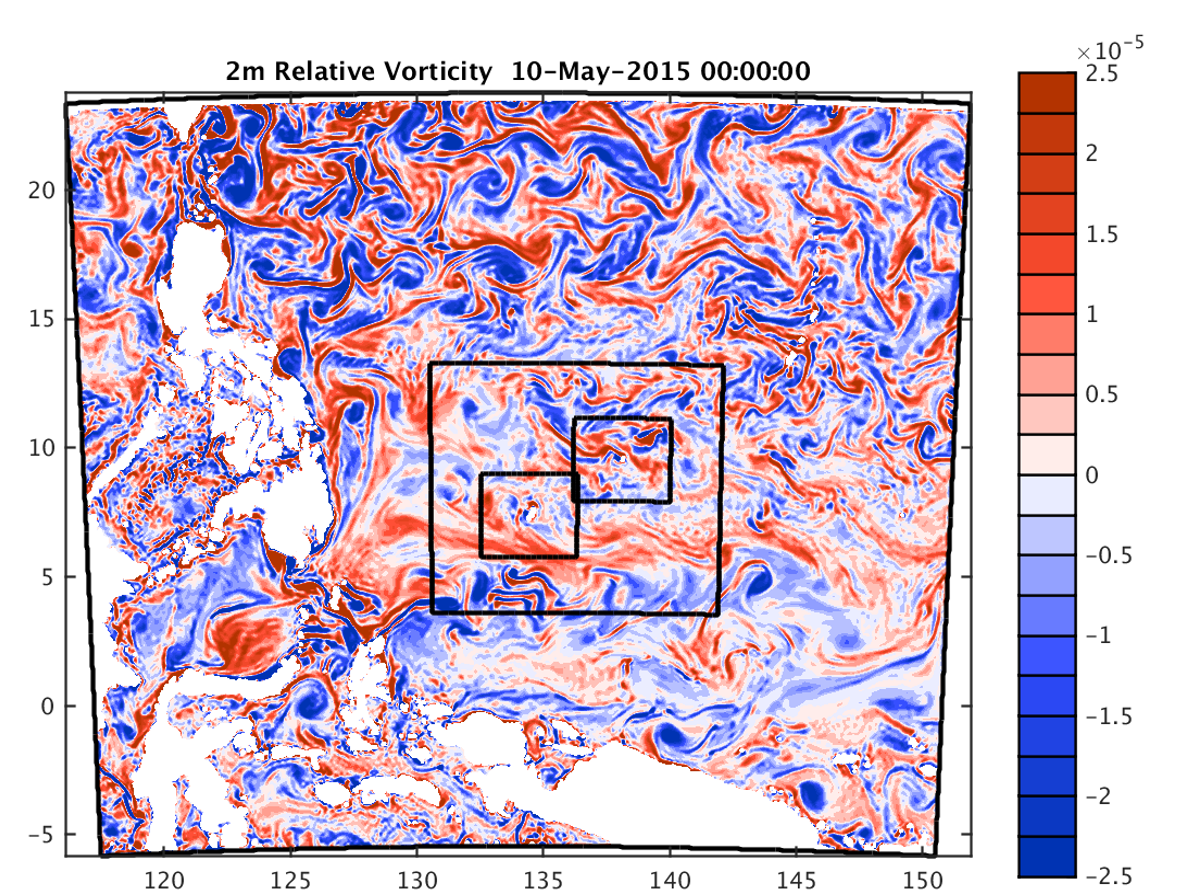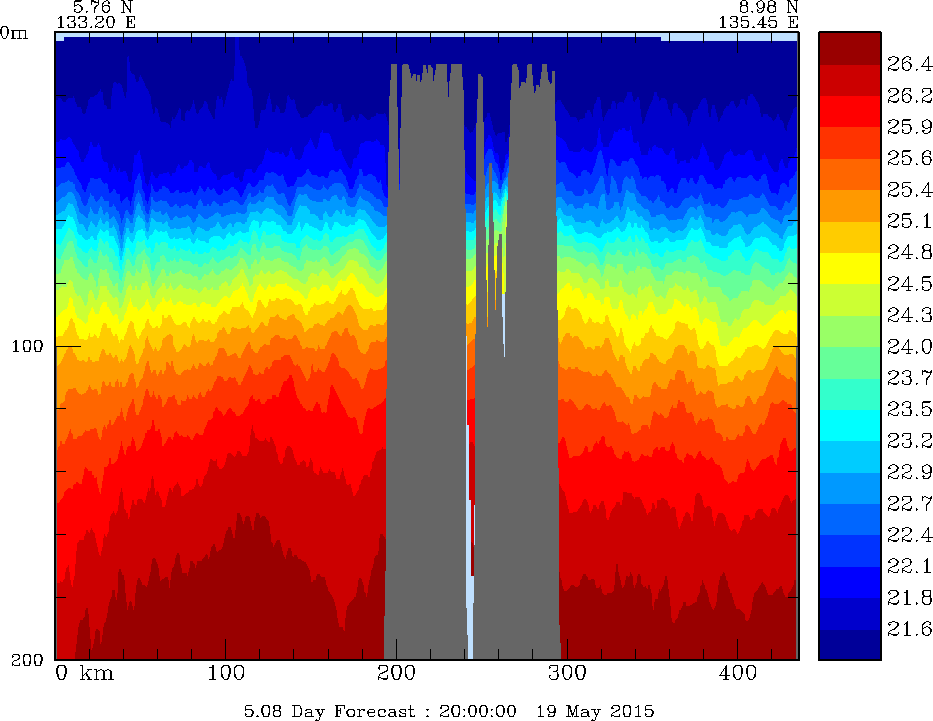High-Order Multi-Resolution Multi-Dynamics Modeling for the
Flow Encountering Abrupt Topography (FLEAT) Initiative
|
P.F.J. Lermusiaux, P.J. Haley, Jr., C. Mirabito Massachusetts Institute of Technology
|
Project Summary Real-time Forecasting Ongoing MIT-MSEAS Research FLEAT-supported Publications Additional FLEAT Links Background Information References
|

|

|
| This research is sponsored by the Office of Naval Research. | |||
Project Summary
The presence of large gradients often renders the quantitative analysis of dynamical systems challenging, be the analysis theoretical, observational or computational. This is because large gradients commonly lead to strong nonlinearities and to coupling among state variables and parameters. The emphasis of the Flow Encountering Abrupt Topography (FLEAT) initiative is on the effects of large topographic gradients and complex subsurface geometry on major current systems. First, the processes involved in these strong topographic interactions are not yet well known. Their consequences, including alteration of circulation features, spawning of internal waves and vortices, and formation of unstable downslope flows and gravity currents, require novel integrated analyses. Second, major ocean ridges and archipelagos and islands are not properly represented in larger-scale modeling systems, and novel downscaling and two-way nesting schemes need to be utilized, developed and evaluated with real ocean data. This set of research activities is the emphasis of our FLEAT research project.
Background information is available below.
| Top of page |
Real-time Forecasting
The MIT-MSEAS PE ocean forecasts for FLEAT in the Pacific Ocean were issued for:
- The Guam region in January 2017. In collaboration with Dr. Kevin Heaney, the objective was to provide sound-speed field forecasts and hindcasts for acoustic studies;
- The Yap region for the second week of April 2017. In collaboration with Dr. Gunnar Voet, our objectives were to utilize the MIT MSEAS primitive-equation modeling system to provide ocean field forecasts that help planning ocean sampling surveys for Lee waves and overflows at ocean ridges.
Modeling products and data sources can be found on the Real-time Forecasts page.
| Top of page |
Ongoing MIT-MSEAS Research
Long-Term (Collaborative) Goal:
Explain and quantify multiscale interactions at abrupt topography among flow systems, vortices, internal tides and/or slope currents
- by using and developing high-order multi-dynamics Hybridizable Discontinuous Galerkin (HDG) schemes for accurate process studies, and
- by using and improving downscaling and two-way nesting schemes for realistic simulations and dynamics analyses.
Specific Objectives:
- Complete process-modeling studies of flows interacting with abrupt topography, with an emphasis on interactions among current systems, circulation features, eddies, topographic waves, internal tides or bottom gravity currents
- Further develop and utilize our high-order HDG schemes for such scientific simulation studies of interactive dynamics at abrupt topography
- Refine and utilize our conservative implicit two-way nesting schemes, nested and open BCs, downscaling schemes, semi-analytical estimation of circulation features, and schemes for adaptive generalized vertical coordinates, so as to allow multi-resolution modeling
- Forecasting and data-assimilative simulations during the sea campaigns, multi-resolution re-analyses, and realistic dynamics analyses
- Collaborate with DRI colleagues and NRL, transferring approaches, algorithms and simulations
Presentations and Meetings
| Top of page |
Additional FLEAT Links
| Top of page |
Background Information
In collaboration with the DRI team, one of our motivations is to quantify processes involved when flows encounter abrupt topographic gradients with complex subsurface features and island chains, with an emphasis on multiscale interactions that occur in the west Mariana Ridge region. A second motivation is to achieve accurate simulations that resolve locally strong gradients over dynamically significant space- and time-scales. To do so, high-order schemes (more accurate for the same efficiency than lower-order schemes) and multi-resolution meshes (allow optimized refinements) are desirable. All of this, as well as conservative and consistency considerations, led us to hybridizable discontinuous Galerkin (HDG) methods (Cockburn et al., 2009a; Nguyen et al, 2009a). Specifically, we derived new HDG schemes for high-order, multi-resolution modeling of incompressible fluid and Boussinesq ocean dynamics (Ueckermann and Lermusiaux, 2010; Ueckermann and Lermusiaux, 2015; Ueckermann et al., 2015; Mirabito et al., 2015). Some of the next research steps are to refine their implementations, study their numerical properties and enable high-order-accurate scientific studies of multi-dynamics interactions. Such interactions will occur in the FLEAT study regions and include circulations with non-hydrostatic and hydrostatic regions, or flows with both geostrophic and strongly ageostrophic motions. Our final motivation is to utilize our MSEAS multiscale modeling capabilities (Haley and Lermusiaux, 2010; Haley et al., 2015), including semi-analytical archipelago flow initialization, data assimilation, sensitivity and diagnostic studies, and Lagrangian analyses.
Specific Research Tasks
Quantitative process studies with high-order multi-resolution multi-dynamics modeling
In collaboration with the DRI team, we explain and quantify multiscale interactions at abrupt topography. We define and set-up flow configurations that encounter abrupt topographic gradients, with or without subsurface features and islands. This involves time and 2D and 3D-in-space studies. To complete these studies, we further develop our HDG codes towards a high fidelity modeling system, capable of multi-dynamics simulations at high-order over multi-resolution meshes. We simulate and study nonlinear dynamics with non-hydrostatic or hydrostatic dynamics turned on. We emphasize the multiscale interactions among the regional features observed, including non-hydrostatic stirring and mixing. We utilize modeling and measurement results to inspire the development of process-oriented dynamical models for these interactions. We also utilize our modeling results during the field campaigns to guide the sea sampling towards key processes and interactions.
Downscaling and implicit two-way nesting of multiple dynamics in complex geometries
For realistic simulations and dynamics analyses in complex geometries, we refine and utilize our nested-grid boundary conditions and conservative multi-grid exchanges such that upscale and downscale effects of multiple dynamics are transferred accurately across the multi-resolution domains. We also utilize and further evaluate our semi-analytical optimization scheme for the estimation of circulation features in complex multiply-connected regions, generalizing the "Island Rule". We improve our generalized vertical coordinate systems for primitive-equations (PEs) with a nonlinear free-surface, implementing model levels that optimally adapt to dynamics, for both our structured finite-volume and unstructured HDG codes. Finally, we implement our HDG solver capability of separating non-hydrostatic and hydrostatic elements.
Realistic data-assimilative multi-resolution modeling and dynamics analyses
We set up and apply our MSEAS PE code for multi-resolution modeling of multiscale tidal-to-mesoscale processes in the FLEAT regions. This involves two-way implicit nesting, parameter tuning, data assimilation, and data-model comparisons. We explain and quantify processes involved when regional currents encounter the abrupt topography, subsurface features and island chains, with an emphasis on multiscale interactions. We complete re-analyses with telescoping two-way nesting, to be used for dynamics analyses. For dynamics analyses, we utilize term-by-term and flux balances, LCSs analyses, time and space variability decompositions, and/or new internal tide extraction equations that we developed.
| Top of page |
References
- Haley, P.J., Jr. and P.F.J. Lermusiaux, 2010. Multiscale two-way embedding schemes for free-surface primitive-equations in the Multidisciplinary Simulation, Estimation and Assimilation System. Ocean Dynamics, 60, 1497-1537. doi:10.1007/s10236-010-0349-4.
- Haley, P.J., Jr., A. Agarwal, P.F.J. Lermusiaux, 2015. Optimizing Velocities and Transports for Complex Coastal Regions and Archipelagos. Ocean Modeling, 89, 1-28. doi:10.1016/j.ocemod.2015.02.005
- Ueckermann, M.P. and P.F.J. Lermusiaux, 2010. High Order Schemes for 2D Unsteady Biogeochemical Ocean Models. Ocean Dynamics, 60, 1415-1445, doi:10.1007/s10236-010-0351-x.
- Ueckermann, M.P. and P.F.J. Lermusiaux, 2016. Hybridizable Discontinuous Galerkin Projection Methods for Navier-Stokes and Boussinesq Equations. Journal of Computational Physics, 306, 390-421. doi:10.1016/j.jcp.2015.11.028
| Top of page |



